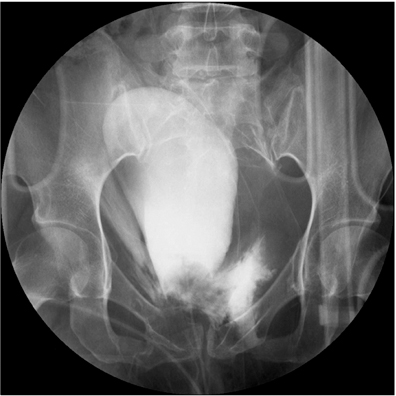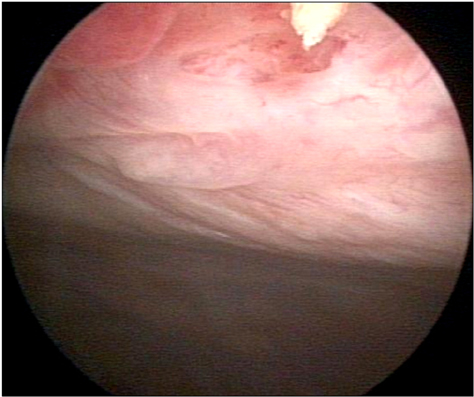Korean J Urol.
2012 Dec;53(12):887-889. 10.4111/kju.2012.53.12.887.
Delayed Presentation of Intravesical Bone Penetration after Pelvic Ring Fracture
- Affiliations
-
- 1Department of Urology, Chung-Ang University College of Medicine, Seoul, Korea. caucih@cau.ac.kr
- 2Department of Orthopaedic Surgery, Chung-Ang University College of Medicine, Seoul, Korea.
- KMID: 1988738
- DOI: http://doi.org/10.4111/kju.2012.53.12.887
Abstract
- Retrograde cystography and computed tomography (CT) are considered the gold standard for investigating bladder and pelvic bone injury. However, these methods can miss extraperitoneal bladder rupture caused by a penetrating bone fragment from a pelvic bone fracture. We experienced a routine conventional cystography and CT scan that failed to identify penetration of the bladder by a bone fragment, which thus delayed optimal treatment. Therefore, different diagnostic methods such as CT cystography or cystoscopy should be considered to rule out penetrating injury by a bony fragment in patients with extraperitoneal bladder rupture.
Keyword
Figure
Reference
-
1. Heetveld MJ, Poolman RW, Heldeweg EA, Ultee JM. Spontaneous expulsion of a screw during urination: an unusual complication 9 years after internal fixation of pubic symphysis diastasis. Urology. 2003. 61:645.2. Avey G, Blackmore CC, Wessells H, Wright JL, Talner LB. Radiographic and clinical predictors of bladder rupture in blunt trauma patients with pelvic fracture. Acad Radiol. 2006. 13:573–579.3. Carroll PR, McAninch JW. Major bladder trauma: mechanisms of injury and a unified method of diagnosis and repair. J Urol. 1984. 132:254–257.4. Andrich DE, Day AC, Mundy AR. Proposed mechanisms of lower urinary tract injury in fractures of the pelvic ring. BJU Int. 2007. 100:567–573.5. Carroll PR, McAninch JW. Major bladder trauma: the accuracy of cystography. J Urol. 1983. 130:887–888.6. Chan DP, Abujudeh HH, Cushing GL Jr, Novelline RA. CT cystography with multiplanar reformation for suspected bladder rupture: experience in 234 cases. AJR Am J Roentgenol. 2006. 187:1296–1302.
- Full Text Links
- Actions
-
Cited
- CITED
-
- Close
- Share
- Similar articles
-
- Relationship of the patterns of pelvic bone fracture and bladder rupture
- Delayed bladder perforation due to screw loosening after pelvic ring injury surgery: a case report
- Pelvic Bone Stress Fracture after Lumbar Spinal Fusion: Two Cases Report
- Massive Hemorrhage Caused by a Non-Displaced Pubic Ramus Fracture from Low-Energy Trauma
- Pelvic Ring Injury





